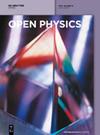High-speed mid-infrared Mach–Zehnder electro-optical modulators in lithium niobate thin film on sapphire
IF 1.8
4区 物理与天体物理
Q2 PHYSICS, MULTIDISCIPLINARY
引用次数: 0
Abstract
In this study, high-speed mid-infrared Mach–Zehnder electro-optical modulators in x-cut lithium niobate (LN) thin film on sapphire were designed, simulated, and analyzed. The main optical parameters of three types of Mach–Zehnder modulators (MZMs) (residual LN with thickness of 0, 0.5, and 1 μm) were simulated and calculated, namely, the single-mode conditions, bending loss, separation distance between electrode edge and lithium niobate waveguide edge, optical field distribution, and half-wave voltage–length product. The main radio frequency (RF) parameters of these three types of MZMs, such as characteristic impedance, attenuation constant, RF effective index, and the –3 dB modulation bandwidth were calculated depending on the dimensions of the coplanar waveguide traveling-wave electrodes. The modulations with residual LN thickness of 0, 0.5, and 1 μm were calculated with bandwidths exceeding 140, 150, and 240 GHz, respectively, and the half-wave voltage–length product achieved was 22.4, 21.6, and 15.1 V cm, respectively. By optimizing RF and optical parameters, guidelines for device design are presented, and the achievable modulation bandwidth is significantly increased.蓝宝石上的铌酸锂薄膜中的高速中红外马赫-泽恩德电光调制器
本研究设计、模拟和分析了蓝宝石上 x 切面铌酸锂(LN)薄膜中的高速中红外马赫-泽恩德电光调制器。模拟并计算了三种马赫-泽恩德调制器(残留铌酸锂厚度分别为 0、0.5 和 1 μm)的主要光学参数,即单模条件、弯曲损耗、电极边缘与铌酸锂波导边缘的分离距离、光场分布和半波压长积。根据共面波导行波电极的尺寸,计算了这三种类型 MZM 的主要射频(RF)参数,如特性阻抗、衰减常数、RF 有效指数和 -3 dB 调制带宽。计算得出的 LN 剩余厚度为 0、0.5 和 1 μm 时的调制带宽分别超过 140、150 和 240 GHz,实现的半波电压-长度乘积分别为 22.4、21.6 和 15.1 V cm。通过优化射频和光学参数,提出了器件设计指南,并显著提高了可实现的调制带宽。
本文章由计算机程序翻译,如有差异,请以英文原文为准。
求助全文
约1分钟内获得全文
求助全文
来源期刊

Open Physics
PHYSICS, MULTIDISCIPLINARY-
CiteScore
3.20
自引率
5.30%
发文量
82
审稿时长
18 weeks
期刊介绍:
Open Physics is a peer-reviewed, open access, electronic journal devoted to the publication of fundamental research results in all fields of physics. The journal provides the readers with free, instant, and permanent access to all content worldwide; and the authors with extensive promotion of published articles, long-time preservation, language-correction services, no space constraints and immediate publication. Our standard policy requires each paper to be reviewed by at least two Referees and the peer-review process is single-blind.
 求助内容:
求助内容: 应助结果提醒方式:
应助结果提醒方式:


